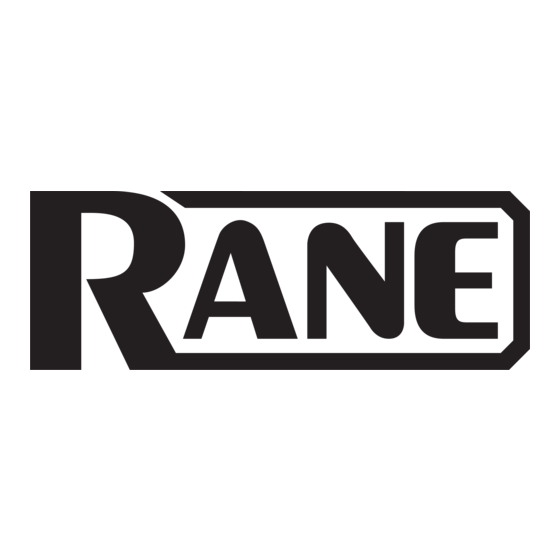Table of Contents
Advertisement
Quick Links
Advertisement
Table of Contents

Summary of Contents for Rane AD 13
- Page 3 If you do not send in the registration card (“I forgot.”), or you do not have a sales s1ip from an authorized Rane dealer (“My dog ate it.”), the warranty period will only extend two (2) years from the date of manufacture.
-
Page 4: Front Panel Description
LED display. THIS BUTTON ALSO CAUSESTHE DELAY SETTING OF THE PREVIOUSLY SELECTED CHANNELTO BE STORED IN THE NON-VOLATILE MEMORY OF THE AD 13. 4. OUTPUT CHANNEL POINTER: This LED pointer alerts the operator to the channel number currently being displayed by the LED display. - Page 5 9. CHANNEL 2 OUTPUT LEVEL CONTROL: See channel 1 output level control immediately above. 10. CHANNEL 3 OUTPUT LEVEL CONTROL: See channel 1 output level control immediately above the item immediately above. 11. OUTPUT OVERLOAD INDICATORS: These red LEDs illuminate exactly 4 dB below the onset of clipping, should any of the respective output stages approach this sort of difficulty.
-
Page 6: Rear Panel Description
III. REAR PANEL DESCRIPTION 1. 3-PIN INPUT CONNECTOR: This is a differential active balanced input, connected such that pin 2 is HOT, pin 3 is RETURN, and pin 1 is signal ground, NOT SHIELD GROUND. Shield ground should only be connected to the case of the connector. 2. - Page 7 Don’t forget to keep that pencil sharp. Now that a full understanding of digital audio has been assured, we can proceed with the nuts and bolts description of the Rane AD 13.
-
Page 8: Functional Description
So, you have read the previous page and you’re ready to continue. Use the block diagram as a pictorial guide as we describe the signal path of the AD 13. It will help you a lot. AD 13 BLOCK DIAGRAM In the beginning, signal is applied at the input either through the 3-pin connector or the barrier strip. - Page 9 Unlike the example which was required reading on the previous page, the converter in the AD 13 runs at a 50kHz sample rate (just to be sure). It will then produce a binary number in the range of 0 to 16,383 (no, this is not binary; binary would be “in the range of 00000000000000 to 11111111111111”), at every 1/50,000 second interval.
-
Page 10: System Connection
Be sure to leave pin 3 open on outputs and tie it to pin 1 on inputs. Connecting it to ground or to pin 2 on the output connector will cause excessive current to flow and disrupt signal fidelity. This will cause no damage to the AD 13, only to your signal path. - Page 11 “off” positions. This will further ensure that there are no unwanted glitches. When the power switch on the AD 13 is turned on, the display will illuminate with the word RANE and will stay in that condition for approximately 2 seconds. During this time the CPU performs its self-test functions which guarantees that it will function when the unit switches to its active mode.
- Page 12 Whether or not you have set the desired delays, you may, at any time, increase the input control to a comfortable level and any or all of the output controls. Since the AD 13 is normally going to function at the input of the amplifier, there should rarely be any need for anything but unity gain at either the input or the outputs.
-
Page 13: Specifications
VIII. SPECIFICATIONS TIME DELAY Range: 0 to 655ms Increment Size: 20µs or 1 ms throughout entire range Readout: 3 digit LED with autoranging decimal point. Accuracy: ±5% DATA CONVERTERS Conversion Rate: 50kHz oversampling Type: Linear pulse code modulation (PCM). (Philips CD data converters). Quantity: 4 (1 A/D, 3 D/A) ANTI-ALIASING &...












